Part 1 of 3: The importance of play

Flickr 3381658687_801c1fa1d0_z
I used to see play as the opposite of work, but then I was often working at jobs I did not enjoy, to simply pay the bills and get health insurance while raising two children and putting a husband through graduate school.
I now know the importance of play to keep work energizing.
It wasn’t until I began my own practice as a coach where I was in charge of developing who and what I wanted to do, that I began to understand the importance of play.
“The opposite of play is not work, it is depression.” This aphorism of Stuart Brown, M.D. (Brown & Vaughan, 2009, p. 123), noted play researcher and president at The National Institute for Play, has been extensively quoted because it resonates with so many people. Play is a catalyst for good work and learning at any age. When learners at any age are having fun, they are more likely to pursue their ideas. Sometimes play lets inventors and researchers keep noodling away at a problem to come up with different, better than good-enough solutions, or with getting out of prescribed cultural boxes and assumptions.
Playfulness allows optimism and creativity, which create new possibilities. Proyer (2011) has found that playfulness can equate with better personal and academic performance, as well as with helping people actually enjoy their current projects.
To play while exploring any idea means using the imagination to engage in problem-solving and to appreciate that an investigation of ideas is an opportunity to discover the world like a kid again.
An example of play leading to an invention
One lovely summer day in 1948, a Swiss amateur mountaineer and inventor decided to take his dog for a nature hike. The man and his faithful companion both returned home covered with burrs, the plant seed-sacs that cling to animal fur in order to travel to fertile new planting grounds. The man neglected his matted dog, and with a burning curiosity ran to his microscope and inspected one of the many burrs stuck to his pants. He saw all the small hooks that enabled the seed-bearing burr to cling so viciously to the tiny loops in the fabric of his pants. George de Mestral raised his head from the microscope and smiled thinking, “I will design a unique, two-sided fastener, one side with stiff hooks like the burrs and the other side with soft loops like the fabric of my pants. I will call my invention “velcro” a combination of the word velour and crochet. It will rival the zipper in its ability to fasten (as told by S. D. Strauss in The Big Idea, 2001, pp. 15-18).
Work and Play Are Not Opposites
Traditionally, work and play are thought of as opposites. In academia and life, nothing should be further from the truth. Many people started in a field because they love something so much they couldn’t wait to learn everything there was to know about it and maybe even discover something new. The incredible demands of juggling multiple and sometimes competing responsibilities for academics with teaching, research, and administration with an enjoyable life can cause the play factor to wither. It’s the same for people in the business world trying to create a new entity from their seminal ideas, and often with the need to expand into areas they are not particularly interested in, like making money, handling the accounting, doing the marketing, answering inquiries of all sorts by telephone, email and other methods of communication. All of this taking away from the time they would rather be actually “playing” with their ideas.
Working on something new—letting the mind play—will ease feelings of being overwhelmed and lack of fun. It can also get you unstuck when you feel caught in a rut.
As a company, Google has taken this idea to heart: For 20 percent of their time, employees may go where their minds ask them to go. The proof is in the bottom line: fully 50 percent of new products, including Gmail and Google News, came from the 20 percent “free,” mind-wandering time (Medina, 2008). A hypothesis still under investigation is that play may actually contribute to the growth and development of the cerebellum, even influencing how we interact socially (Zull, 2001).
If you are working with others to get a project done, make sure to laugh. Laughing eases tension, and at times, new ideas are born of the humorous take on an idea. Groups in laboratory and academic settings can especially benefit from lightening up. The black humor of surgery is well-known to people in hospitals as a way to ease the tension.
To cultivate humor in relation to your work, post cartoons about your work on your office door. Gary Larson is still a favorite for biological scientists. Encourage your colleagues by giving them humorous stories about the work in their field. There are many places you can get ideas for this, like a funny pictures website even website dedicated to academic humor, such as PhDcomics.com, that can be particularly useful for distressed graduate students or new professors trying to get a little perspective on their situation.
Solemnity and seriousness are not the same. You can have fun and still be serious about your work. To paraphrase Friedrich Nietzsche (1909), “The struggle of maturity is to recover the seriousness of the child at play.” I could say more about the relationship of having fun to invention and research, but it would take a book to do so. And some of those have already been written by other people. For now, the take-away idea should be if you are not having fun in your life while working hard ask yourself, “How can I make this project fun?”
Look for some upcoming blogs on forms of play:
Part 2: Video games
Part 3: Physical play
Until then, have fun!
Tags: play, the importance of play







A good reminder, Hillary, thank you!
Thanks for the feedback, Robin. I think play is something any professional really needs to pay attention to if they want to keep doing something they love!